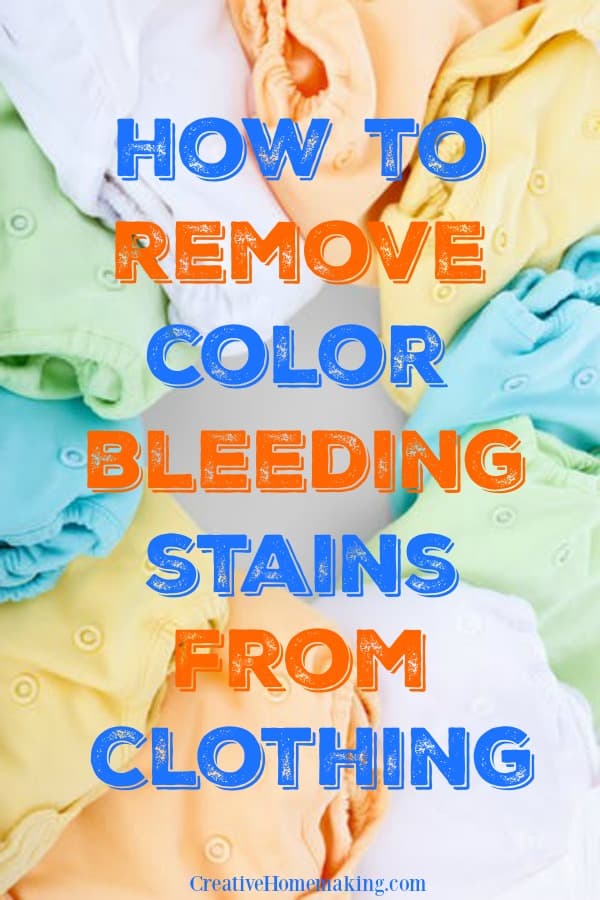Are you tired of finding your white clothes stained with colors from other garments? Color bleeding is a common problem that can happen to anyone, even if you take extra care of your clothes.
This post may contain affiliate links.
But don’t worry, getting color bleed out of clothes is not as difficult as you might think. With a few simple steps, you can easily remove color stains and restore your clothes’ original color.
The first thing you need to do when you notice color bleeding is to act fast. The longer you wait, the harder it will be to remove the stain. Start by separating the affected garment from the rest of your clothes and rinse it under cold water.
Avoid using hot water as it can set the stain and make it harder to remove. In the next section, we’ll go over some effective methods to get rid of color bleed stains.
Related Article: How to Clean Tennis Shoes in the Washing Machine: A Step-by-Step Guide
Understanding Color Bleed
When you wash clothes, it’s common to mix different colors together. However, sometimes colors from one garment can bleed onto another, leaving stains that are difficult to remove. Understanding color bleed can help you prevent it from happening and save your clothes.
Color bleed happens when the dye from one fabric transfers onto another fabric. This can occur when clothes are washed together, or when a wet garment comes into contact with another garment.
The degree of color bleed depends on several factors, including the type of fabric, the color, and the temperature of the water.
Dark and bright colors are more prone to bleeding than light colors. Synthetic fabrics, such as polyester and nylon, are more likely to bleed than natural fibers, such as cotton and wool. Hot water can also cause colors to bleed more than cold water.

Related Article: How to Dry Shoes Fast: Tips and Tricks for Quick Drying
To prevent color bleed, sort your clothes by color and fabric type before washing. Wash dark and bright colors separately from light colors. You can also use color catchers, which are sheets that absorb color in the wash, to prevent colors from bleeding onto other clothes.
If your clothes have already suffered from color bleed, don’t worry. There are ways to remove the stains. However, it’s important to act fast. The longer the stain sits, the harder it will be to remove.
In the next section, we’ll discuss some methods for removing color bleed stains from clothes.
Preventing Color Bleed
Color bleeding is a common problem that can ruin your favorite clothes. However, you can prevent color bleeding by taking a few precautions. Here are some tips to prevent color bleed:
Sorting Clothes Properly
Sorting your clothes properly before washing is an important step to prevent color bleeding. Separate your clothes based on color and wash them separately.
This will ensure that dark-colored clothes do not bleed onto lighter-colored clothes. You can also sort clothes based on fabric type to prevent damage to delicate fabrics.
Using Color Catchers
Color catchers are a great way to prevent color bleeding. They are small sheets that you can add to your laundry to trap loose dyes.
Color catchers work by absorbing loose dyes that may bleed during the wash. This prevents the dyes from staining other clothes. Make sure to follow the instructions on the package for best results.
Pre-Washing New Clothes
New clothes are more likely to bleed than older clothes. To prevent color bleeding, it is important to pre-wash new clothes before wearing them. This will remove any excess dye that may bleed during the wash. Wash new clothes separately from other clothes to prevent color transfer.
By following these tips, you can prevent color bleeding and keep your clothes looking new for longer. Remember to always read the care label on your clothes for specific washing instructions.
Removing Color Bleed
If you’ve accidentally mixed colors in the wash, you may notice that some of your clothes have color bleed. This can be frustrating, but don’t worry, there are several ways to remove color bleed from your clothes. Here are three methods you can try:
Using Bleach
Bleach can be an effective way to remove color bleed from white clothes. However, it’s important to note that bleach can damage colored fabrics, so it’s best to use it only on whites. To use bleach, follow these steps:
- Fill a sink or basin with cold water.
- Add 1/4 cup of bleach for every gallon of water.
- Soak the affected clothes in the solution for 15-30 minutes.
- Rinse the clothes thoroughly with cold water.
- Wash the clothes with detergent as usual.
Using Vinegar
Vinegar is a natural and safe way to remove color bleed from clothes. It’s also effective on both white and colored fabrics. Here’s how to use vinegar:
- Fill a sink or basin with cold water.
- Add one cup of white vinegar for every gallon of water.
- Soak the affected clothes in the solution for 30 minutes.
- Rinse the clothes thoroughly with cold water.
- Wash the clothes with detergent as usual.
Using Commercial Color Removers
If you don’t have success with the previous methods, you can try using a commercial color remover. These products are specifically designed to remove color bleed and are available at most grocery and home goods stores. Follow the instructions on the packaging for best results.
Related Article: Removing Armpit Odors from Shirts: Effective Tips and Tricks
Remember to always check the care label on your clothes before attempting to remove color bleed. Some fabrics may not be able to withstand certain methods, and you could end up causing more damage.
With these methods, you can save your clothes from color bleed and keep them looking great for longer!
Caring for Color-Bleed Affected Clothes
If you’ve accidentally washed your clothes with a color that bled onto them, don’t worry. With the right care, you can still wear your clothes without the unsightly stains. Here are some tips on how to care for your color-bleed affected clothes.
Drying Tips
When drying your clothes, it’s important to avoid high heat. High heat can set the color bleed stains, making them harder to remove. Instead, opt for air-drying your clothes. If you prefer to use a dryer, choose a low heat setting.
Another tip is to separate your color-bleed affected clothes from your other clothes. This will prevent the color from spreading to other garments. You can also use a color catcher sheet in the dryer to absorb any remaining color.
Ironing Tips
Ironing color-bleed affected clothes can be tricky. It’s best to avoid ironing directly on the stain, as this can set it in further. Instead, place a clean, white cloth over the stain and iron over the cloth. This will help to lift the stain out of the fabric.
Related Article: Mysterious Water or Bleach Spots on Clothing
If the stain is still visible after ironing, try using a fabric-safe stain remover. Be sure to test the stain remover on a small, inconspicuous area of the garment first to ensure it doesn’t damage the fabric.
Remember, always read the care label on your clothes before attempting to remove color-bleed stains. Some fabrics may require special care or professional cleaning.
Conclusion
Getting color bleed out of clothes can be a frustrating experience, but it’s not impossible. With the right tools and techniques, you can save your clothes from permanent damage.
Remember to always act quickly when you notice color bleeding, as the longer you wait, the harder it will be to remove the stain.
Use cold water and avoid heat, as heat can set the stain and make it more difficult to remove.
Related Article: Removing Lint from Bath Towels
If you’re dealing with a tough stain, try using a stain remover or bleach alternative. Be sure to follow the instructions carefully and test on a small, inconspicuous area first.
Prevention is key when it comes to color bleeding. Always separate your clothes by color and wash them in cold water. Consider using color catchers in your wash to prevent color bleeding.
By following these tips, you can keep your clothes looking their best and avoid the frustration of color bleeding.
Frequently Asked Questions
What is the best color stain remover for clothes?
There are many color stain removers available in the market, but the best one depends on the type of fabric and the severity of the stain. Some popular options include OxiClean, Clorox 2, and Shout Color Catcher.
Always follow the instructions on the product label and test on a small, inconspicuous area of the fabric before using it on the entire garment.
Related Article: How to Clean a Burnt Iron
How can I remove color bleeding from clothes using vinegar?
Vinegar is a natural and effective way to remove color bleeding from clothes. Mix equal parts of white vinegar and water and soak the stained garment in the solution for at least 30 minutes. Then, wash the garment as usual with a mild detergent.
Is it possible to remove dye transfer stains from colored clothes without bleach?
Yes, it is possible to remove dye transfer stains from colored clothes without using bleach. You can use a color-safe stain remover or a mixture of baking soda and water to remove the stain.
Apply the solution to the stain and let it sit for 30 minutes before washing the garment as usual.
How can I get dye out of clothes after washing?
If you notice dye transfer after washing, you can try using a color remover product. Follow the instructions on the product label and test on a small, inconspicuous area of the fabric before using it on the entire garment.
Alternatively, you can try soaking the garment in a mixture of vinegar and water for 30 minutes before washing it again.
Can baking soda help remove color bleed from clothes?
Yes, baking soda can help remove color bleed from clothes. Mix 1/2 cup of baking soda with warm water to create a paste and apply it to the stained area. Let it sit for 30 minutes before washing the garment as usual.
How do I fix color bleeding on clothes?
If you notice color bleeding on your clothes, the best way to fix it is to prevent it from happening in the first place. Always sort your laundry by color and wash similar colors together.
If you do notice color bleeding, try using a color-safe stain remover or a mixture of vinegar and water to remove the stain.
Follow my cleaning tips board on Pinterest.




How do you remove color stain from a homemade quilt that some of the colors ran together